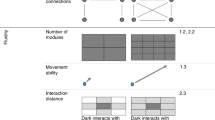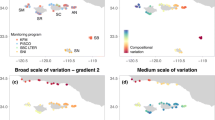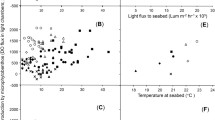Abstract
Recent discussions on scaling issues in ecology have emphasized that processes acting at a wide range of spatial and temporal scales influence ecosystems and thus there is no appropriate single scale at which ecological processes should be studied. This may be particularly true for environmental disturbances (e.g. El Niño) that occur over large geographic areas and encompass a wide range of scales relevant to ecosystem function. However, it may be possible to identify the scale(s) at which ecosystems are most strongly impacted by disturbances, and thus provide a measure by which their impacts can be most clearly described, by assessing scale-dependent changes in the patterns of variability in species abundance and distribution. This, in turn, may yield significant insight into the relative importance of the various forcing factors responsible for generating these impacts. The 1997–98 El Niño was one of the strongest El Niños ever recorded. I examined how this event impacted giant kelp populations in the northeast Pacific Ocean at 90 sites ranging from central Baja California, Mexico to central California, USA. These sites spanned the geographic range of giant kelp in the Northeast Pacific and were surveyed just before, immediately following, several months after, more than 1 year after, and nearly 2 years after the El Niño. I used a hierarchical sample design to compare these impacts at five spatial scales spanning six orders of magnitude, from a few meters to more than 1,000 km. Variance Components Analyses revealed that the El Niño shifted control over giant kelp abundance from factors acting at the scale of a few meters (local control) to factors operating over hundreds to thousands of kilometers (regional control). Moreover, El Niño resulted in the near-complete loss of all giant kelp throughout one-half of the species’ range in the northeast Pacific Ocean. Giant kelp recovery following El Niño was far more complex and variable at multiple spatial scales, presumably driven by numerous factors acting at those scales. Recovery returned local control of giant kelp populations within 6 months in southern California, and within 2 years in Baja California.







Similar content being viewed by others
References
Anderson TW (1994) Role of macroalgal structure in the distribution and abundance of a temperate reef fish. Mar Ecol Prog Ser 113:279–290
Carpenter RC (1985) Sea urchin mass-mortality: effects on reef algal abundance, species composition, and metabolism and other coral reef herbivores. Proceedings of the Fifth International Coral Reef Congress 4:53–60
Carpenter SR (1998) The need for large-scale experiments to assess and predict the response of ecosystems to perturbation. In: Pace ML, Groffman PM (eds) Successes, limitations, and frontiers in ecosystem science. Springer, Berlin Heidelberg New York, pp 287–312
Carr MH (1994) Effects of macroalgal dynamics on recruitment of a temperate reef fish. Ecology 75:1320–1333
Chapman MG, Underwood AJ, Skilleter GA (1995) Variability at different spatial scales between a subtidal assemblage exposed to the discharge of sewage and two control assemblages. J Mar Biol Ecol 189:103–122
Chavez FP (1996) Forcing and biological impact of onset of the 1982–83 El Niño in central California. Geophys Res Lett 23:265–268
Chelton DB, Bernal PA & McGowan JA (1982) Large-scale interannual physical and biological interaction in the California Current. J Mar Res 40:1095–1125
Connell JH, Hughes TP, Wallace CC (1997) A 30-year study of coral abundance, recruitment, and disturbance at several scales in space and time. Ecol Monogr 67:461–488
Dayton PK (1985) Ecology of kelp communities. Annu Rev Ecol Syst 16:215–245
Dayton PK, Tegner MJ (1984a) The importance of scale in community ecology: a kelp forest example with terrestrial analogs. In: Price PW, Slobodchikoff CN, Gaud WS (eds) A new ecology: novel approaches to interactive systems. Wiley, New York
Dayton PK, Tegner MJ (1984b) Catastrophic storms, El Niño, and patch stability in a southern California kelp community. Science 224:283–285
Dayton PK, Tegner MJ (1990) Bottoms beneath troubled waters: benthic impacts of the 1982–1984 El Niño in the temperate zone. In: Glynn PW (ed) Global ecological consequences of the 1982–83 El Niño-Southern Oscillation. Elsevier, Miami
Dayton PK, Tegner MJ, Parnell PE, Edwards PB (1992) Temporal and spatial patterns of disturbance and recovery in a kelp forest community. Ecol Monogr 62:421–445
Dayton PK, Tegner MJ, Edwards PB, Riser KL (1999). Temporal and spatial scales of kelp demography: the role of oceanographic climate. Ecol Monogr 69:219–250
Deutschman DH, Levin SA, Devine C, Buttel LA (1997) Scaling from trees to forests: analysis of a complex simulation model. Science 277:1688
Deysher LE, Dean TA (1986) In situ recruitment of sporophytes of the giant kelp Macrocystis pyrifera (L.) C.A. Agardh: effects of physical factors. J Exp Mar Biol Ecol 103:41–63
Edwards MS (2000) The role of alternate life-history stages of a marine macroalga: a seed bank analogue? Ecology 81:2404–2415
Edwards MS (2001) Scale-dependent patterns of community regulation in giant kelp forests, Ph.D. thesis, UC Santa Cruz
Estes JA, Palmisano JF (1974) Sea otters: their role in structuring nearshore communities. Science 185:1058–1690
Fielder PC (1984) Satellite observations of the 1982–1983 El Niño along the U.S. Pacific coast. Science 224:1251–1254
Foster MS (1990) Organization of macroalgal assemblages in the Northeast Pacific: the assumption of homogeneity and the illusion of generality. Hydrobiologia 192:21–33
Foster MS, Schiel DC (1985) The ecology of giant kelp forests in California: a community profile. Biological Report 85 (7.2). U.S. Fish & Wildlife Service, Washington, D.C.
Foster MS, Schiel DR (1992) Zonation, El Niño disturbance, and the dynamics of subtidal vegetation along a 30 m depth gradient in two giant kelp forests. Proceedings of the Second International Temperate Reef Symposium, pp 151–162
Gabrielson PW, Widdowson TB, Lindstrom SC, Hawkes MW, Scagel RF (2000) Keys to the benthic marine algae and seagrasses of British Columbia, Southeast Asia, Washington, and Oregon. University of British Columbia, Dept. Botany, Vancouver
Gerard VA (1984) Physiological effects of El Niño on giant kelp in Southern California. Mar Ecol Prog Ser 5:317–322
Glynn PW (1988) El Niño-Southern Oscillation 1982–1983: nearshore population, community, and ecosystem responses. Annu Rev Ecol Syst 19:309–345
Graham MH, Edwards MS (2001) Statistical significance versus fit: estimating the importance of individual factors in ecological analysis of variance. Oikos 93:503–513
Graham MH, Harrold C, Lisin S, Light K, Watanabe JM, Foster MS (1997) Population dynamics of giant kelp Macrocystis pyrifera along a wave exposure gradient. Mar Ecol Prog Ser 148:269–279
Graybill MR, Hodder J (1985) Effects of the 1982–83 El Niño on reproduction of six species of seabirds in Oregon. In: Wooster WS, Fluharty DL (eds) El Niño North. Washington Sea Grant Program, Seattle, pp 205–210
Hayward TL, Durazo R, Murphree T, Baumgartner TR, Gaxiola-Castro G, Schwing FB, Tegner M.J, Checkley DM, Hyrenbach KD, Mantyla AW, Mullin MM, Smith PE (1999) The state of the California Current in 1998–1999: transition to cool-water conditions. CalCOFI Rep 40:29–62
Hernández-Carmona G, García O, Robledo D, Foster MS (2000) Restoration techniques for Macrocystis pyrifera (Phaeophyceae) populations at the southern limit of their distribution in México. Bot Mar 43:273–284
Hernández-Carmona G, Robledo D, Serviere-Zaragoza E (2001) Effect of nutrient availability on Macrocystis pyrifera recruitment survival near its southern limit of Baja California. Bot Mar 43:273–284
Hewitt JE, Thrush SF, Legendre P, Cummings VJ, Norkko A (2002) Integrating heterogeneity across spatial scales: interactions between Artina zelandica and benthic macrofauna. Mar Ecol Prog Ser 239:115–128
Hughes TP, Baird AH, Dinsdale EA, Moltschaniwskyj NA, Pratchett MS, Tanner JE, Willis BL (1999) Patterns of recruitment and abundance of corals along the Great Barrier Reef. Nature 397:59–63
Karlson RH, Cornell HV (1998) Scale-dependent variation in local vs. regional effects on coral species richness. Ecol Monogr 68:259–274
Kerr RA (1988) La Niña’s big chill replaces El Niño. Science 241:240–241
Ladah LB, Zertuche-González JA, Hernández-Carmona G (1999) Giant kelp ( Macrocystis pyrifera, Phaeophyceae) recruitment near its southern limit in Baja California after mass disappearance during ENSO 1997–1998. J Phycol 35:1106–1112
Legendre P (1993) Spatial autocorrelation: trouble or new paradigm? Ecology 74:1659–1673
Levin SA (1992) The problem of pattern and scale in ecology. Ecology 73:1943–1967
Levin SA (2000) Multiple scales and the maintenance of biodiversity. Ecosystems 3:498–506
McPhaden MJ (1999) Climate oscillations—genesis and evolution of the 1997–98 El Niño. Science 283:950–954
Menge BA, Olson AM (1990) Role of scale and environmental factors in regulation of community structure. Trends Ecol Evol 5:52–57
Neibauer HJ (1985) Southern Oscillation/El Niño effects in the eastern Bering Sea. In: Wooster WS, Fluharty DL (eds) El Niño North. Washington Sea Grant Program, Seattle, pp 116–120
Pearcy W, Fisher J, Brodeur D, Johnson S (1985) Southern Oscillation/El Niño effects in the eastern Bering Sea. In: Wooster WS, Fluharty DL (eds) El Niño North. Washington Sea Grant Program, Seattle, pp 188–204
Reed DC, Foster MS (1984) The effects of canopy shading on algal recruitment and growth in a giant kelp forest. Ecology 65:937–948
Romme WH, Everham EH, Frelich LE, Moritz MA, Sparks RE (1998) Are large, infrequent disturbances qualitatively different from small, frequent disturbances? Ecosystems 1:524–534
Royer TC (1985) Coastal temperature and salinity anomalies in the northern Gulf of Alaska. In: Southern Oscillation/El Niño effects in the eastern Bering Sea. In: Wooster WS, Fluharty DL (eds) El Niño North. Washington Sea Grant Program, Seattle, pp 107–115
Scheibling RE (1984) Echinoids, epizootics and ecological stability in the rocky subtidal off Nova Scotia, Canada. Helgol Meeresunters 37:233–242
Searle SR, Casella G, McCullouch CE (1992) Variance components. Wiley, New York
Tegner MJ, Dayton PK (1987) El Niño effects on Southern California kelp communities. Adv Ecol Res 17:243–279
Tegner MJ, Dayton PK, Edwards PB, Riser KL (1997) Large-scale, low-frequency oceanographic effects on kelp forest successions: a tale of two cohorts. Mar Ecol Prog Ser 146:117–134
Thompson WA Jr (1962) The problem of negative estimates of variance components. Ann Math Stat 33:273–289
Thompson WA Jr, Moore JR (1963) Non-negative estimates of variance components. Technometrics 5:441–449
Thrush SF, Hewitt JE, Cummings VJ, Green MO, Funnell GA, Wilkenson MR (2000) The generality of field experiments: interactions between local and broad-scale processes. Ecology 81:399–415
Tilman D, Kareiva P (1997) Spatial ecology—the role of space in population dynamics and interspecific interactions. Princeton University Press, New Jersey
Turner MG, Dale VH (1998) Comparing large, infrequent disturbances: what have we learned? Ecosystems 1:493–496
Underwood AJ (1997) Experiments in ecology. Cambridge University Press, Cambridge
Wallace JM (1985) Atmospheric response to equatorial sea-surface temperature anomalies. In: Wooster WS, Fluharty DL (eds) El Niño North. Washington Sea Grant Program, Seattle, pp 9–21
Weins JA (1989) Spatial scaling in ecology. Funct Ecol 3:385–397
Wolter K, Timlin MS (1998) Measuring the strength of ENSO events: How does the 1997/98 rank? Weather 53:315–324
Zholdasova I (1997) Sturgeons and the Aral Sea ecological catastrophe. Environ Biol Fish 48:373–380
Zimmerman RC, Robertson DL (1985) Effects of El Niño on local hydrography and growth of the giant kelp, Macrocystis pyrifera , at Santa Catalina Island, California. Limnology and Oceanography 30:1298–1302
Acknowledgements
I thank J. Estes, P. Raimondi, M. Foster and D. Doak for their advice and encouragement. I thank G. Hernández for his assistance with obtaining permits to work in Mexico and for our many discussions on kelp forest ecology. I thank M. Graham and C. Symms for the time spent discussing statistical procedures. This endeavor could not have been possible without the assistance of more than 70 undergraduate and graduate field assistants who spent countless hours both underwater and on the road. In particular, I would like to thank D. Smith, L. Bass, K. Clark, S. Reizwitz, C. Hansen, M. Bond, P. Dalferro, S. Wilson, J. Engel, and especially D. Steller, who on more than one occasion co-piloted field trips to Baja California. This study was funded by grants from the Monterey Bay Regional Studies (MBRS) Program, The PADI Foundation, UC Mexus and the National Science Foundation (OCE-9813562).
Author information
Authors and Affiliations
Corresponding author
Rights and permissions
About this article
Cite this article
Edwards, M.S. Estimating scale-dependency in disturbance impacts: El Niños and giant kelp forests in the northeast Pacific. Oecologia 138, 436–447 (2004). https://doi.org/10.1007/s00442-003-1452-8
Received:
Accepted:
Published:
Issue Date:
DOI: https://doi.org/10.1007/s00442-003-1452-8




